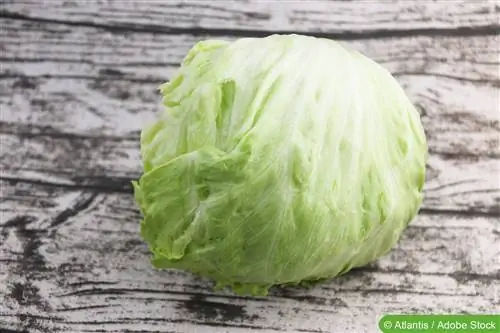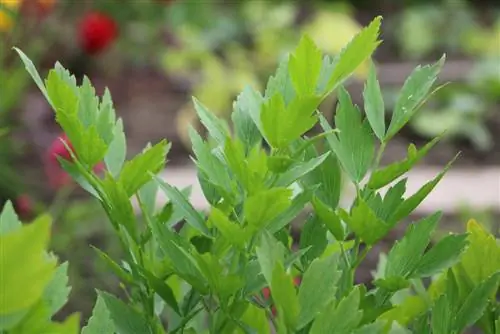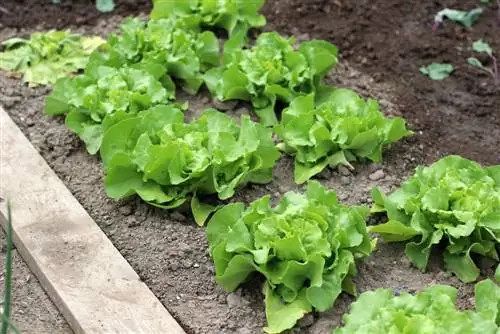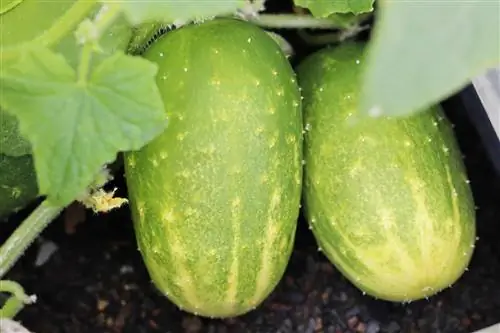- Author admin [email protected].
- Public 2023-12-17 03:39.
- Last modified 2025-01-24 12:45.
Iceberg lettuce is a further breeding of lettuce and is now very popular. There is not much to consider from sowing to harvest. The lettuce can be grown in pots from March or April or sown straight away in the outdoor bed. It makes sense to sow this salad in stages so that it can then be harvested until autumn. The last possible date for sowing is therefore July.
Steps to follow:
- The soil should be loose and nutrient-rich
- Sowing from March to July at the most
- Remove weeds and loosen the soil at regular intervals
- Fertilize with compost if necessary
- Always ensure there is enough water
- Protect against pests with culture nets
Sunny location is important
The seeds don't have to go very deep into the soil because iceberg lettuce needs the sun to germinate. To do this, a temperature of 10 to 15 degrees must be reached so that the seeds can germinate sufficiently. Water well after sowing and always keep moist. Like all salads, this one also needs a lot of water. So that the iceberg lettuce can develop well, the individual heads should be 30 centimeters apart. If the plants are too close, simply remove the weakest ones. This creates space and allows the strong plants to develop better.
Regularly loosen the soil and fertilize
So that the iceberg lettuce gets everything it needs, the soil should be loosened regularly with a rake. It is also important that fertilizer is added regularly so that the lettuce receives all its nutrients. Simple compost is suitable for this and can be mixed in when raking. This also removes the weeds at the same time, as this has to be done regularly. This was all the requirements of iceberg lettuce. You can harvest after about 2 or 3 months. Like all vegetables, it is best to harvest them early in the morning.
Pests also like lettuce
Pests also include snails. These can simply be collected or an appropriate trap can be set up. What helps without resorting to chemicals are snail caps. These are simply placed over the young lettuce so that the snails can no longer get to it. But also old flower pots where the bottoms are simply removed and simply placed over the lettuce. This means that the snails can no longer get to the delicious young leaves. Because when the iceberg lettuce is larger, the snails no longer like the darker leaves. However, if the garden has a he althy environment, then it also provides snail killers that are found in nature. This includes birds and hedgehogs, because they love snails and especially the voracious slugs. Nature can also help itself.
Cutter eats the lettuce
To avoid these nasty pests in the garden, you should put a cultural protection net over the lettuce. This prevents the nocturnal butterfly from laying its eggs and the garden remains free of these pests. Since they live underground and eat the roots, there is no other way to combat them. These cultural nets also protect other vegetable plants that could otherwise become infected. These pests can be identified by searching the soil. If someone finds such a caterpillar, it will curl up when touched. Picking up helps but is not effective. Therefore the motto here is that prevention is better than no salad. These culture nets also help against aphids at the same time.
Harvest iceberg lettuce correctly
In order to harvest the ripe lettuce, the head should be cut off just above the ground. As a rule, it is a salad that is naturally clean. In the actual sense, it wouldn't have to be washed. But since we are so used to it, it can be washed in standing water. Then simply spin dry in the salad spinner. If flies infest you, you can simply add s alt to the water. So these flies simply fall off and the lettuce then simply has to be washed again in clear water. This also applies to aphids, which like to eat salad just as much as we humans do. Above all, this salad can easily be stored in the vegetable compartment. The long shelf life in particular makes this even more popular. If the salad has already been cut, simply put it in a plastic bag and then put it in the fridge.
Easy to care for with good results
Whether grown in pots or sown directly in the bed, iceberg lettuce is not very demanding in its requirements. Therefore, like lettuce, it can be easily planted by beginners. With this salad there is almost a guaranteed harvest as long as you don't forget to water. What makes this salad so popular is the variety in how it can be dressed. This is also because iceberg lettuce remains crisp and fresh even after being dressed for a long time. Especially if there is a barbecue party, the salad has to wait a little longer. If there are enough nutrients in the soil and if the weeds are removed regularly, then there will be a plentiful harvest. However, it should be protected against a sudden cold snap. Iceberg lettuce doesn't like anything below 10 degrees. Contrary to its name, it cannot tolerate ice and snow. So you are guaranteed to always have fresh salad from the garden.
Growing & Care of Iceberg Lettuce
Iceberg lettuce can be sown in pots or directly outdoors from March or April. It makes sense to sow in several stages so that you can continually harvest fresh lettuce. The last possible date for this is July. It takes two to three months from sowing to harvest, so you can harvest in this way until autumn.
The iceberg lettuce seeds are only lightly covered with soil because they need sufficient light for germination. After sowing, the soil is watered and kept evenly moist over the following period. At a temperature of 10° to 15°C, germination occurs within one to two weeks. When planting out in the garden, the plants are spaced about 30 centimeters apart so that each can develop a sufficiently large head. If sown directly into a bed, the weakest plants should be removed.
Iceberg lettuce prefers a sunny to partially shaded spot in the garden and well-drained and nutrient-rich soil. During the period when the heads are developing, it needs sufficient water. Regular hoeing keeps the beds free of weeds, otherwise the iceberg lettuce does not require any special care. Additional fertilization is not necessary if the soil is regularly supplied with some compost. The best way to harvest iceberg lettuce is to cut off the entire head just above the ground. As with many other vegetables, the best time to harvest is early morning.
The planting and care tips in summary:
- Sowing: from March
- Location: sunny to partially shaded
- Soil: loose and nutrient-rich
- Planting distance: 30 centimeters
- Ensure adequate watering
- Fertilization: not necessary
Using iceberg lettuce
Because the leaves have a firm structure, iceberg lettuce is not only suitable for serving appetizers on the leaves, but also for burgers or as a fresh salad bowl. The leaves can be used to serve a side salad very well, of course on a small plate or in a small bowl. Iceberg lettuce loves a mild climate, which is why its cultivation is not always successful in our latitudes. Growing areas tend to be Spain, France, Italy and the south of Germany. It needs heat from the ground and above, so growing it is a bit difficult. Iceberg lettuce is available in supermarkets and greengrocers all year round, even if imported lettuce heads are available here.
The iceberg lettuce not only has a long shelf life (up to 2 weeks in the vegetable compartment), it also retains its freshness even after it has already been cut. Simply wrap the cut head of lettuce in cling film and it will keep in the fridge for another week. Iceberg lettuce is also naturally clean. This means that there is no need to wash the individual sheets. The outer, loose leaves are removed before preparation and the salad can be easily cut into fine strips. If you still want to wash it, it's better to do it swimmingly. After washing, spin dry and simply prepare, such as lettuce. Since salads consist mostly of water, they are safe to eat, they don't make you fat and are also low in calories.






